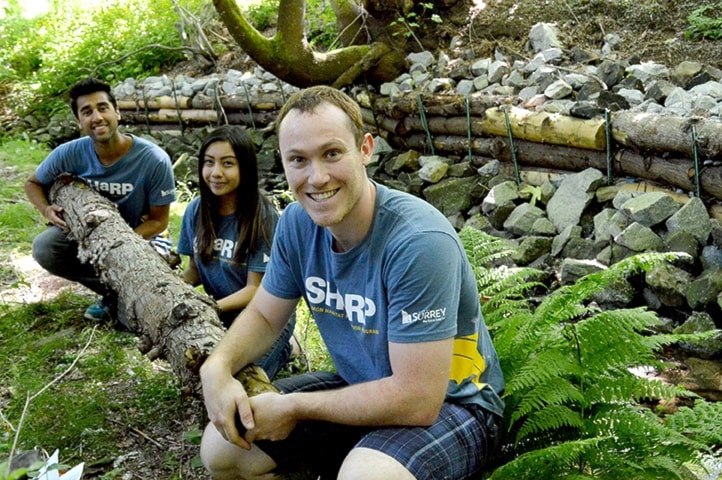SURREY — Ever heard of a weir?
I hadn't - until I was given a tour of a creek at Queen Mary Park.
A weir is a barrier that alters water flow, sometimes used to prevent floods. But this weir in Whalley wasn't there for that reason. It was there to oxygenate the water for the salmon.
It was built by Salmon Habitat Restoration Program (SHaRP), which is celebrating its 20th anniversary this year.
"It looks kind of like a dam but it's not," said Supreet Malhi of the weir. He's on SHaRP's Watershed Enhancement Team this year.
"So during the winter months, the water flow will be a lot heavier and it will go over that gravel there that you see that's kind of dry. As it goes over and cascades over the rocks it'll be oxygenated. Salmon will jump that and go up the stream."
The city is home to more than 1,400 kilometres of waterways and 300 of those are fish bearing. SHaRP is about protecting and enhancing those assets.
From invasive plant removal to water quality testing to stream enhancement and even public and business education, one can only imagine how much impact the teams have had over the last two decades.
At Queen Mary Park - just one of about 70 sites SHaRP is working at this year - the weir is but a sampling of the work that's been undertaken over the last 15 years.
Back then, it was a barren bank with a stream cutting through it.
Today, it's prime salmon habitat. The bank has been reinforced with rebar, large rocks and logs to avoid erosion, native plants have gone in along the bank, invasive plants have been removed, and much more - all thanks to SHaRP.
It's obvious why reinforcing a bank will help protect the creek, but why the planting?
"Overgrowing vegetation provides shade and protection from predators," explained Malhi. "Then, because there's vegetation there's going to be bugs which will fall into the water so the salmon can eat them. There's also a lot of big rocks that now provide oxygenation in the water. It keeps the water temperature down, which is also really important for the salmon."
Singh, who is studying environmental science at SFU, said in addition to restoration and protection work, public education is an equally important part of what SHaRP does.
"It makes it a lot more local for community members when they see the salmon run on the news. The Fraser (River) has 4.5 million salmon running through it? Oh whatever. But if you see it coming up your backyard you realize that if you dump something out on the street it's going to end up right here," he said. "And it's going to kill whatever I see right here."
Also on SHaRP's Watershed Enhancement Team this year is JP Hervieux, who recently graduated from the University of Calgary with a degree in environmental science.
He encourages the public to head down to one of the many local salmon-spawning streams.
"You can come out most of the year and see salmon in the streams. The adult salmon will spawn here in the fall, so residents can come for a look," he said. "You can see the baby salmon - the fry - in the stream."
Since its inception 20 years ago, SHaRP has employed well over 500 high school and university students.
"It's a great opportunity for youth employment," said Hervieux. "It's a summer job for high school and university students, and they get some infield experience."
Malhi echoed that. "I had no desire to do environmental work in Grade 10, but when I graduated I joined for a summer job, and now I'm taking environmental science at SFU. I think it does change a lot of peoples' minds," said Malhi.
